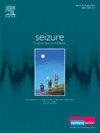耐药局灶性癫痫的神经炎症升高和区域特异性临床相关性
IF 2.8
3区 医学
Q2 CLINICAL NEUROLOGY
引用次数: 0
摘要
目的:约三分之一的癫痫患者对传统的抗癫痫药物难以耐受。来自动物和人类的证据表明,癫痫和神经炎症之间存在双向关系,这可能是一种新的治疗途径。本研究使用[18F]FEPPA研究神经炎症和药物难固性局灶性癫痫之间的区域特异性关系。[18F]FEPPA是新一代转运蛋白放射性配体和小胶质细胞密度的生物标志物,与[11C]PK11195相比,具有良好的结合动力学和信噪比。方法从威斯康星大学健康癫痫监测单位或威斯康星州戴恩县地区招募年龄在18-55岁的患者和年龄匹配的典型对照受试者进行横断面研究。除海马硬化外,患者在MRI上没有明显异常,患者被诊断为局灶性癫痫。临床变量从图表回顾、访谈和患者发作日志中获得。成像数据在GE Signa 3T PET/MR系统上获取,使用PETSurfer进行处理,并使用标准摄取值(suv)从运动校正的PET图像中量化FEPPA结合。结果分析排除了基于TSPO基因多态性的低结合亲和力的参与者(n = 2对照)或缺少影像学资料的参与者(n = 4),导致12例患者(年龄=38.3±13.1岁,4名女性)和9例典型对照(年龄=35.2±10.2岁,4名女性)。与对照组相比,癫痫患者FEPPA摄取普遍增加。FEPPA摄取与癫痫发作频率、近期、持续时间和终生局灶-双侧强直阵挛发作之间存在显著的区域特异性相关性。在一名额叶癫痫患者的发作前后扫描中,观察到癫痫发作后相对于发作间期更大的中颞叶摄取,提示继发性癫痫发生。FEPPA与全身炎症标志物无关。结论研究结果详细说明了局灶性癫痫中神经炎症、癫痫发作活动和恢复之间的区域特异性相互作用。随着癫痫发作时间的增加,内嗅皮层FEPPA suv的减少[18F]表明其可能作为癫痫后恢复的动态指标,而海马和杏仁核摄取的改变可能作为疾病负担的静态标志物。这些结果为进一步研究神经炎症作为癫痫治疗靶点奠定了基础,并支持将[18F]FEPPA PET作为疾病负担和治疗反应的生物标志物整合到临床实践中。本文章由计算机程序翻译,如有差异,请以英文原文为准。
Elevated neuroinflammation and region-specific clinical correlates in drug-resistant focal epilepsy
Purpose
Approximately one-third of patients with epilepsy become refractory to traditional anti-seizure medications. Evidence from animals and in humans suggests a bidirectional relationship between epilepsy and neuroinflammation, offering potential as a novel therapeutic pathway. This study investigates region-specific relationships between neuroinflammation and medication-refractory focal epilepsy using [18F]FEPPA, a next-generation translocator protein radioligand and biomarker for microglial density with favorable binding kinetics and signal-to-noise ratio compared to [11C]PK11195.
Methods
Patients aged 18–55 years and age-matched typical control participants were recruited for this cross-sectional study from the from the UW Health Epilepsy Monitoring Unit or the Dane County, Wisconsin area. Patients demonstrated no gross abnormalities on MRI other than hippocampal sclerosis and patients received a diagnosis of focal epilepsy. Clinical variables were obtained from chart review, interviews, and a patient seizure log. Imaging data were acquired on a GE Signa 3T PET/MR system, processed using PETSurfer, and FEPPA binding was quantified from motion-corrected PET images using standard uptake values (SUVs).
Results
Analysis excluded participants with low binding affinity based on TSPO genetic polymorphism (n = 2 controls) or missing imaging data (n = 4), resulting in 12 patients (age=38.3 ± 13.1 years, 4 female) and 9 typical controls (age=35.2 ± 10.2 years, 4 female). Patients with epilepsy showed widespread increases in FEPPA uptake compared to controls. Significant region-specific correlations were revealed between FEPPA uptake and seizure frequency, recency, duration, and lifetime focal-to-bilateral tonic-clonic seizures. In one patient with frontal lobe epilepsy and pre- and post-ictal scans, greater mesiotemporal uptake was observed following seizure relative the interictal period, suggestive of secondary epileptogenesis. FEPPA did not correlate with systemic inflammatory markers.
Conclusion
Findings detail a region-specific interplay between neuroinflammation, seizure activity, and recovery in focal epilepsy. Reductions in entorhinal cortex [18F]FEPPA SUVs with increasing time from seizure suggest its potential as a dynamic index of post-ictal recovery, while altered uptake in the hippocampus and amygdala may serve as more static markers of disease burden. These results lay the groundwork for further investigation of neuroinflammation as a therapeutic target in epilepsy and support the potential integration of [18F]FEPPA PET into clinical practice as a biomarker of disease burden and treatment response.
求助全文
通过发布文献求助,成功后即可免费获取论文全文。
去求助
来源期刊

Seizure-European Journal of Epilepsy
医学-临床神经学
CiteScore
5.60
自引率
6.70%
发文量
231
审稿时长
34 days
期刊介绍:
Seizure - European Journal of Epilepsy is an international journal owned by Epilepsy Action (the largest member led epilepsy organisation in the UK). It provides a forum for papers on all topics related to epilepsy and seizure disorders.
 求助内容:
求助内容: 应助结果提醒方式:
应助结果提醒方式:


